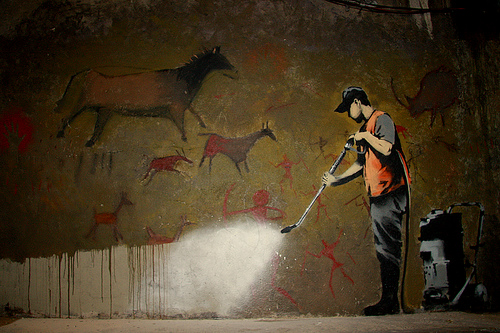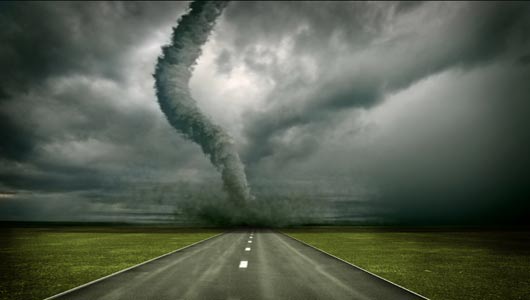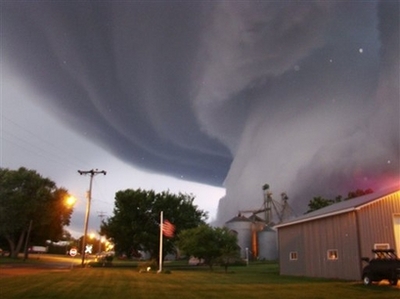All right, here's the story.
The Intergovernmental Agency on Climate Change was created in 1989. It was set up by the World Meteorological Organization (WMO) and the United Nations Environment Program (UNEP), two agencies of the United Nations. The initial task for the IPCC as outlined in the UN General Assembly Resolution 43/53 of 6 December 1988 was to prepare a comprehensive review and recommendations with respect to the state of knowledge of the science of climate change; social and economic impact of climate change, possible response strategies and elements for inclusion in a possible future international convention on climate.
The IPCC says the following of itself.
The Intergovernmental Panel of Climate Change is the leading body for the assessment of climate change, established by the United Nations Environment Programme (UNEP) and the World Meteorological Organization (WMO) to provide the world with a clear scientific view on the current state of climate change and its potential environmental and socio-economic consequences.

"The IPCC is a scientific body. It reviews and assesses the most recent scientific, technical and socio-economic information produced worldwide relevant to the understanding of climate change. It does not conduct any research nor does it monitor climate related data or parameters. Thousands of scientists from all over the world contribute to the work of the IPCC on a voluntary basis. Review is an essential part of the IPCC process, to ensure an objective and complete assessment of current information. Differing viewpoints existing within the scientific community are reflected in the IPCC reports."
And says the following about it's proceedures.
In the course of the multi-stage review process, both expert reviewers and governments are invited to comment on the accuracy and completeness of the scientific/technical/socio economic content and the overall balance of the drafts. The circulation process among peer and government experts is very wide, with hundreds of scientists looking into the drafts to check the soundness of the scientific information contained in them. The Review Editors of the report (normally two per chapter) make sure that all comments are well taken into account.
The IPCC first assessment report was completed in 1990, and served as the basis of the United Nations Framework Convention on Climate Change (UNFCCC).
 The executive summary of the WG I Summary for Policymakers report states,
The executive summary of the WG I Summary for Policymakers report states,
"We are certain of the following: emissions resulting from human activities are substantially increasing the atmospheric concentrations of the greenhouse gases: CO2, methane, CFCs and nitrous oxide. These increases will enhance the greenhouse effect, resulting on average in an additional warming of the Earth's surface. The main greenhouse gas, water vapour, will increase in response to global warming and further enhance it.
We calculate with confidence that: ...CO2 has been responsible for over half the enhanced greenhouse effect; long-lived gases would require immediate reductions in emissions from human activities of over 60% to stabilise their concentrations at today's levels...
Based on current models, we predict: under [BAU] increase of global mean temperature during the [21st] century of about 0.3 oC per decade (with an uncertainty range of 0.2 to 0.5 oC per decade); this is greater than that seen over the past 10,000 years; under other ... scenarios which assume progressively increasing levels of controls, rates of increase in global mean temperature of about 0.2 oC [to] about 0.1 oC per decade.
There has been dissent with regards to the quality of the science, the quality of peer review, the validity of computer modeling used to make predictions, and the integrity of the process itself.
In The Greenhouse Debate Continued: An Analysis and Critique of the IPCC Climate Assessment, a panel of climate scientists from Great Britain, Germany, Sweden, New Zealand, Australia, and the United States independently reviewed the three IPCC documents and found numerous discrepancies between them. Major discrepancies include:
The 1990 "Policymakers Summary" claims that climate warming during the past 100 years is "broadly consistent with predictions of [theoretical] climate models" The 1990 Report and 1992 Supplement, however, present no firm evidence from human-induced greenhouse warming in the climate record.
The Summary predicts a rapid increase in global temperatures, based on climate model calculations. The Report questions the reliability of current climate models, none of which have been validated by existing climate data.
The Summary claims to be "certain" that water vapor, the most important greenhouse gas, will "further enhance" any warming effect from human-produced increases in carbon dioxide. The Report stresses the lack of observational data on the distribution of water vapor and on the role of clouds.

During the summer of 1991, the Science & Environmental Policy Project mailed questionnaires to the more than 100 U.S. IPCC contributors and reviewers, as well as to a group of atmospheric scientists, active in research but not involved in IPCC. Of the 126 surveys mailed, 37 percent were returned, many with signatures.
Only about half of the respondents thought that the Policymakers Summary reflects the text accurately; a majority said that the Summary did not reflect their own views and might convey a misleading message to policymakers. About 90 percent agreed with the following statement (on page 254 of the Report): "It is not possible to attribute all, or even a large part, of the observed global-mean warming to the enhanced greenhouse effect on the basis of observational data currently available". Only 15 percent believed that current GCMs accurately portrayed the atmosphere-ocean system, and less than 10 percent thought that current GCMs had been adequately validated by the climate record.
The other survey, conducted by Greenpeace International, polled 400 climate scientists who had worked on the IPCC study or had published on relevant issues during 1991. The key question was: "Do you think there will be a point of no return, at some [unspecified] time in the future at which continued business-as-usual policies run a serious risk of instigating a runaway greenhouse effect?" Of the 113 respondents, 13 percent said "Probably" and 47 percent said "Probably not."
The SEPP makes the following statement.
The SEPP analysis raises doubts about IPCC claims--put forth in the Foreword to the 1990 Report and in the 1992 Supplement--that the documents had undergone "peer review" prior to their release. The IPCC claim implies a conventional scientific review process in which an editor, independent of the research, enlists scientists to critique a report anonymously. Here, the editors' who were also among the authors, simply circulated the draft to a known group of colleagues, and then accepted or disregarded comments according to their own views. The editors admit to "minority" opinions, which they "have not been able to accommodate." But independent surveys of IPCC scientists demonstrate a substantial majority disagrees with the major assertions of the "Policymakers Summary"--which has been touted as "a international scientific consensus."
When the IPCC report, Climate Change 1995: The Science of Climate Change (Cambridge University Press, May 1996) was printed, it was discovered that significant changes and deletions had been made to Chapter 8 , a crucial part of the report dealing with the detection and attribution of global warming. Moreover, these changes had been made after the draft report had been approved by the government delegations.
, a crucial part of the report dealing with the detection and attribution of global warming. Moreover, these changes had been made after the draft report had been approved by the government delegations. 
 Dr. S. Fred Singer founder of the Science and Environmental Policy Project (SEPP) alerted scientists who had contributed to the IPCC report via the internet. As a result of Dr. Singer's on-line correspondence, a letter reprimanding the IPCC, signed by a dozen climate scientists, was published in the January 1997 issue of the Bulletin of the American Meteorological Society; a similar letter appears in August issue of Physics Today.
Dr. S. Fred Singer founder of the Science and Environmental Policy Project (SEPP) alerted scientists who had contributed to the IPCC report via the internet. As a result of Dr. Singer's on-line correspondence, a letter reprimanding the IPCC, signed by a dozen climate scientists, was published in the January 1997 issue of the Bulletin of the American Meteorological Society; a similar letter appears in August issue of Physics Today.
A Dec. 20, 1995, Reuters report quoted British scientist  Keith Shine, one of IPCC's lead authors, discussing the IPCC Policymakers’ Summary: "We produce a draft, and then the policymakers go through it line by line and change the way it is presented.... It's peculiar that they have the final say in what goes into a scientists' report."
Keith Shine, one of IPCC's lead authors, discussing the IPCC Policymakers’ Summary: "We produce a draft, and then the policymakers go through it line by line and change the way it is presented.... It's peculiar that they have the final say in what goes into a scientists' report."
On April 23, 1998,  Michael E. Mann, Raymond S. Bradley
Michael E. Mann, Raymond S. Bradley and Stephen Malcolm K. Hughes published an paper in Nature Magazine which began as follows;
and Stephen Malcolm K. Hughes published an paper in Nature Magazine which began as follows;
"Spatially resolved global reconstructions of annual surface temperature patterns over the past six centuries are based on the multivariate calibration of widely distributed high-resolution proxy climate indicators. Time- dependent correlations of the reconstructions with time-series records representing changes in greenhouse-gas concentrations, solar irradiance, and volcanic aerosols suggest that each of these factors has contributed to the climate variability of the past 400 years, with greenhouse gases emerging as the dominant forcing during the twentieth century. Northern Hemisphere mean annual temperatures for three of the past eight years are warmer than any other year since (at least) AD 1400."
Within this article, was a graph labelled Figure 5b of the authors calculations of Northern Hemisphere mean temperature changes for the past 600 or so years. This graph referred to by the authors as the MBH98 reconstruction has become famous as
"The Hockey Stick"
In 2001 The Intergovernmental Panel on Climate Change (IPCC) published  "The IPCC Third Assessment Report, Climate Change 2001" wherein "The Hockey Stick Graph"
"The IPCC Third Assessment Report, Climate Change 2001" wherein "The Hockey Stick Graph" became a prominent part of the evidence supporting the theory of man made Global Warming.
became a prominent part of the evidence supporting the theory of man made Global Warming.
The IPCC Third Assessment Report reaches the following conclusions;
An increasing body of observations gives a collective picture of a warming world and other changes in the climate system (The global average surface temperature has increased over the 20th century by about 0.6 °C; Temperatures have risen during the past four decades in the lowest 8 kilometers of the atmosphere; Snow cover and ice extent have decreased)

The TAR estimate for the climate sensitivity is 1.5 to 4.5 °C; and the average surface temperature is projected to increase by 1.4 to 5.8 Celsius degrees over the period 1990 to 2100, and the sea level is projected to rise by 0.1 to 0.9 meters over the same period. The wide range in predictions is based on scenarios that assume different levels of future CO2 emissions. Each scenario then has a range of possible outcomes associated with it. The most optimistic outcome assumes an aggressive campaign to reduce CO2 emissions; the most pessimistic is a "business as usual" scenario. Other scenarios fall in between."
The report goes on to say,
"There is new and stronger evidence that most of the warming observed over the past 50 years is attributable to human activities."
Stephen McIntyre and
and  Ross McKitrick published a paper in Energy and Environment v14 #6, 2003 entitled
Ross McKitrick published a paper in Energy and Environment v14 #6, 2003 entitled
CORRECTIONS TO THE MANN et. al. (1998) PROXY DATA BASE AND NORTHERN HEMISPHERIC AVERAGE TEMPERATURE SERIES
This paper begins as follows:
The data set of proxies of past climate used in Mann, Bradley and Hughes (1998,
“MBH98” hereafter) for the estimation of temperatures from 1400 to 1980
contains collation errors, unjustifiable truncation or extrapolation of source data,
obsolete data, geographical location errors, incorrect calculation of principal
components and other quality control defects.
We detail these errors and defects.
We then apply MBH98 methodology to the construction of a Northern Hemisphere
average temperature index for the 1400-1980 period, using corrected and updated
source data.
The major finding is that the values in the early 15th century exceed
any values in the 20th century.
The particular “hockey stick” shape derived in the MBH98 proxy construction – a temperature index that decreases slightly between the early 15th century and early 20th century and then increases dramatically up to 1980 — is primarily an artefact of poor data handling, obsolete data and incorrect calculation of principal components.
As you might reasonably expect, the fecal matter hit the fan almost immediately. Name calling broke out all over the place.
In an effort to defend their work, Michael Mann, Raymond Bradley and their associates, established their blog Real Climate.org
An example of a third party response to the McIntyre, McKitrick paper can be found here. 
In an effort to defend their work, McIntyre and McKitrick established their site Climate Audit.org
McIntyre and McKitrick defended their work in a presentation to the National Academy of Sciences Expert Panel on March 2, 2006 
Here they repeated their objections to both the original and updated studies by "Mann et. al."
The study used “new” statistical methods that turned out to “mine” for hockey stick shaped series. These methods were misrepresented and/or inaccurately described in important particulars and their statistical properties were either unknown to the authors or unreported by them.
The reconstruction failed an important verification test said to have used in the study. This failure was not reported and the statistical skill was misrepresented both in the original article and by the IPCC.
Dominant weight was placed on proxies known to be inappropriate temperature proxies, along with, at best, misleading information about their impact and, at worst, actual withholding of adverse results;
The method of confidence interval calculation leads to unrealistically narrow confidence intervals;
Systematic obstruction was placed at every step of the way of replication attempts. The underlying data were exceedingly hard to identify and obtain. The methodology was not accurately described in the paper and the computational code was withheld until the intervention of a Congressional investigation.
On January 24, 2006 climatologists at the NASA Goddard Institute for Space Studies announced that the highest global annual average surface temperature in more than a century was recorded in their analysis for the 2005 calender year.
A study by NASA scientists published September 25, 2006 stated that that the world's temperature is reaching a level that has not been seen in thousands of years.
Climatologists at the NASA Goddard Institute for Space Studies (GISS) in New York City on January 6, 2008 announced that 2007 tied with 1998 for Earth’s second warmest year in a century. And that eight warmest years in the GISS record have all occurred since 1998, and the 14 warmest years in the record have all occurred since 1990.
And that eight warmest years in the GISS record have all occurred since 1998, and the 14 warmest years in the record have all occurred since 1990.
Stephen McIntyre (who seems to have time on his hands) again set out to verify the Goddard Institutes data, and methodolgy. And found that NASA like Mann, does not fully publish the computer source code or the formulae they use to calculate the trends within their data. Having reverse engineered NASA Goddard's process using the raw data and the processed data, he published a paper stating that having demonstrating the errors within NASA Goddard's findings.
NASA was forced to correct their findings.
In November of 2008 the Goddard Institute for Space Studies release it's statistics for October of 2008, and announced that October 2008 had been the warmest October on record, ever. Within the data were findings that across Russia, temperatures were on average 10 degrees higher than normal for the month of October.
Stephen McIntyre (yet again), and Anthony Watts found this strange, since London had experienced its first October snow in 70 years.
found this strange, since London had experienced its first October snow in 70 years. Chicago and the Great Plains states had broken several lowest-temperature records
Chicago and the Great Plains states had broken several lowest-temperature records , some of which had stood for 120 years. Tibet had broken snowfall records. Glaciers in Alaska, the Alps and New Zealand had begun advancing. Sea ice expanded so rapidly it covered 30% more of Arctic than at the end of October 2007.
, some of which had stood for 120 years. Tibet had broken snowfall records. Glaciers in Alaska, the Alps and New Zealand had begun advancing. Sea ice expanded so rapidly it covered 30% more of Arctic than at the end of October 2007. 
Review of the data found that September 2008 data had been substituted for the true October data.
Nasa, Goddard was forced to correct themselves, again.
True believers in climate change would have you believe that the debate is over.
After all, 2500 scientists can't be wrong!!!
But wait, 31,407 scientists say, "It ain't so !!!!!!!!!!!!! 


















































![[Most Recent Quotes from www.kitco.com]](http://www.kitconet.com/charts/metals/gold/t24_au_en_usoz_2.gif)




![[Most Recent Quotes from www.kitco.com]](http://www.kitconet.com/charts/metals/silver/t24_ag_en_usoz_2.gif)





